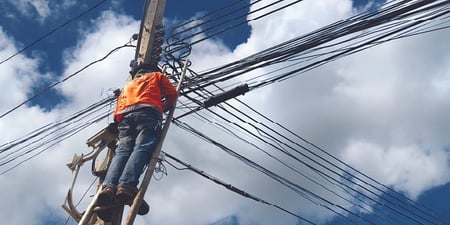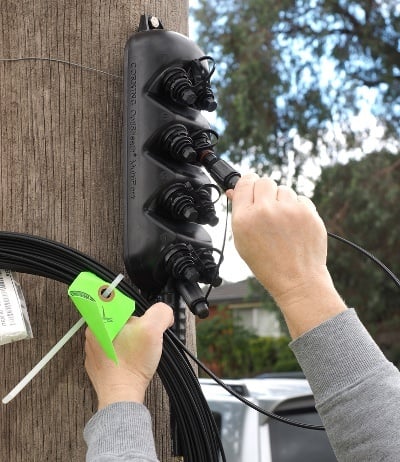 With a plethora of aerial fiber cable products on the market today it can be difficult to differentiate and fully appreciate why one construction is or isn’t more suitable than another.
With a plethora of aerial fiber cable products on the market today it can be difficult to differentiate and fully appreciate why one construction is or isn’t more suitable than another.
This blog aims to outline the different options once you’ve decided to go down the aerial route – for a more detailed look at the factors affecting the choice of aerial deployments take a look at this previous post.
Taking a very broad overview of the aerial installation solutions presently available, there are two distinct approaches: either installing fiber into an aerial drop tube or microduct, or deploying a stand-alone self-supporting cable.
Normally the fiber-in-duct approach will require two installation phases, whereas the self-supporting aerial cable route can be deployed in one stage. From this you’d assume that the self-supporting cable solution reduces labor costs.
But this is actually not the case, so let’s delve deeper and further subdivide these two options into two more, assessing each for the total cost outlay, installation time and applicability in different areas of a fiber network.
1. Fiber In-Duct
Blown Fiber
Costs are comparatively high since the microduct must be deployed before fiber can be blown. The additional time and cost of the blowing head and compressor makes this an unattractive solution unless the plant/equipment is already owned. While the time to install the microduct is no different than installing a constructed cable solution, blowing fiber is a lengthy process. For this reason it is not well suited to final drops, but does still have applications where fiber routes are long, hard to access, or where planners value installing a fiber raceway that can readily be revisited for future upgrades and maintenance.
Following the microduct and fiber deployment, the fibers must be spliced by a trained optical engineer which, again, can consume time, depending on their availability. Blowing fiber certainly still has benefits. And if the planner were looking to build a future-proof network where fibers can more easily be replaced with minimum disruption, a fiber cable-in-duct solution would be the best option. As with all cable-in-duct scenarios, the fiber is separate from the microduct and therefore protected from high tensile loads.
Fiber can be successfully blown up to two miles and farther if blowing heads are run in tandem - although real world scenarios are likely to be less than one mile. This makes blown fiber highly unsuitable for last drops, but where multiple fibers need to be routed further than a few hundred meters, blown fiber becomes a contender.
Pushable Fiber
Similar to blown fiber, this is a two stage installation process which first requires microduct to be lashed to utility poles. It is this second stage where the cost comparison can be made since the fiber is pushed/pulled rather than air-blown. Installation speeds are comparable to blown fiber ranging between 20-50 feet per minute by hand, or with aid of a battery powered pushing machine in excess of 100 feet per minute.
The pushable fiber cable is much smaller than an aerial cable (in the region of 1/8 of an inch) and, because it is manufactured from an indoor rated material, can be safely routed inside a building following the aerial deployment. The sheath of the pushable fiber cable will be much more rugged than a blown fiber tube or bundle, as well as utilizing a harder material than an aerial cable or microduct, which are usually of the polyethylene variety.
In Fiber to the Home (FTTH) installations, it is possible to pre-terminate a connector onto the pushable fiber cable, reducing the need to splice the fibers at both ends of the drop cable. In terms of limitations, it is really only advantageous to use it in last drops or short metropolitan area networks where fiber counts are between one and 48 and routes don’t exceed 1,000 feet.
2. Pre-Fibered Self Supporting Cable
Loose Tube
 These are larger than "fiber in-duct" cables, with a single fiber version typically in the ¼ to ½ inch region. While pre-terminated options are available they require bulky, cumbersome connectors so can be a little unwieldy. The cost of loose tube aerial cable is determined largely by the number of fiber tubes in it. Some cables have a rectangular or oval design or, when round, are constructed with empty "filler" tubes for lower count cables.
These are larger than "fiber in-duct" cables, with a single fiber version typically in the ¼ to ½ inch region. While pre-terminated options are available they require bulky, cumbersome connectors so can be a little unwieldy. The cost of loose tube aerial cable is determined largely by the number of fiber tubes in it. Some cables have a rectangular or oval design or, when round, are constructed with empty "filler" tubes for lower count cables.
In terms of installation the process is largely similar to microduct deployments, and when it comes to splicing the cable it will require a level of deconstruction in order to access the individual element tubes. This makes the process much more cumbersome, especially when network terminals are located in different locations or the fibers need to be accessed mid-span.
Compared to cable-in-duct practices a loose tube cable will be faster to deploy since it requires just one truck roll. However, the process of accessing fibers and, if necessary, routing them some distance into the dwelling can be very time consuming for even the skilled splice technician.
Loose tube aerial cables are highly suited to long deployments, up to and beyond what was traditionally feasible with blown fiber. Depending on the pay-off capabilities of the installation crews and the landscape, continuous lengths of 30,000ft (+5 miles) of fiber cable are not uncommon. This makes aerial loose tube fiber cable ideal for building backbone networks or long metropolitan area trunk lines.
Tight Buffered
These typically follow the same design and construction as loose tube cables, with the obvious exception that the fiber sets (normally 12 fibers each) are tightly sheathed and therefore are not able to move freely. Pricing will also be similar with perhaps small savings because tight buffer is less expensive to manufacture. However, the fibers will be at higher risk once the cable is stripped for termination.
Installation costs are the same as loose tube with a single installation phase to get the fiber deployed but will also require routing to the termination box and splicing, as per loose tube cable. The plant/equipment requirement is the same so while beneficial for higher fiber counts, it works less well for low count drop cables where a single splice technician could be required to terminate fibers across the network in a range of locations.
Unfortunately, tight buffered cables are not best suited to long hauls (over 1 km) since the processing of the fibers can potentially add stress to the glass. It is therefore a viable and cost effective alternative for metropolitan area or FTTH drop cables but less suitable for backbone fiber.
When it comes to aerial deployments, every installation is different.
To succeed you therefore need to understand the advantages of each approach in different conditions and parts of the network in order to minimize cost and installation time in order to ensure a reliable, high quality deployment.
Image 2: STRINGER/Shutterstock.com



